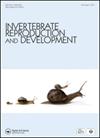温度驱动海参浮游幼虫休眠的实验证据
IF 0.8
4区 生物学
Q4 REPRODUCTIVE BIOLOGY
引用次数: 0
摘要
摘要尽管幼虫生态学是具有多阶段生活史的海底生物种群动态的核心,但许多物种对幼虫对环境变化的适应仍不完全了解。利用海参棘皮动物Isostichopus fuscus,我们研究了浮游性物种如何利用能力前可塑性来长期承受次优温度条件。五组繁殖体(胚胎/幼虫)在标准化培养环境中接受温度处理(28-29、24-25和20-22°C)。在最冷的温度下(典型的近海上升流区域),发育反映了在温暖的温度下获得的发育,直到耳轮藻早期,在那里发育以与静止一致的方式停滞了约5个月。当温度再次升高时,幼虫迅速恢复发育并定居;没有发现持久的负面影响。研究结果表明,幼虫可以利用一种休眠形式,在不确定的时间内承受次优的海洋条件,直到成功地转移到合适的近海位置,那里是fuscus的专属栖息地。本文章由计算机程序翻译,如有差异,请以英文原文为准。
Experimental evidence suggesting temperature-driven dormancy in the planktotrophic larvae of the sea cucumber Isostichopus fuscus
ABSTRACT While larval ecology is central to the population dynamics of marine benthic species with multiphasic life histories, the adaptations of larvae to environmental variability remain incompletely understood in many species. Using the holothuroid echinoderm (sea cucumber) Isostichopus fuscus, we examined how a planktotrophic species can use pre-competency plasticity to withstand suboptimal conditions of temperature over extended periods. Five cohorts of propagules (embryos/larvae) were exposed to temperature treatments (28–29, 24–25 and 20–22°C) in standardized culture settings. Under the coldest temperatures (typical of offshore upwelling areas), development mirrored that obtained under warmer temperatures until the early auricularia stage, where development was arrested for ~5 months in a manner consistent with quiescence. When temperature was increased again, larvae quickly resumed development and settled; no lasting negative impact was noted. The findings suggest that the larvae can use a form of dormancy to withstand suboptimal oceanic conditions for indefinite periods of time until successful delivery to appropriate inshore locations, the habitat were I. fuscus is exclusively found.
求助全文
通过发布文献求助,成功后即可免费获取论文全文。
去求助
来源期刊
CiteScore
1.90
自引率
0.00%
发文量
21
审稿时长
>12 weeks
期刊介绍:
Invertebrate Reproduction & Development ( IRD) presents original research on the reproductive and developmental biology of the Invertebrata, both embryonic and postembryonic. IRD welcomes papers reporting significant results obtained using new techniques. Encouraged topic areas include: aquaculture, physiology, biochemistry, functional morphology, phylogeny, behavioural and regulatory mechanisms, including genetic, endocrine and molecular studies. Papers containing qualitative descriptions of reproductive cycles and gametogenesis will not be considered. IRD is published in association with the International Society of Invertebrate Reproduction and Development.

 求助内容:
求助内容: 应助结果提醒方式:
应助结果提醒方式:


